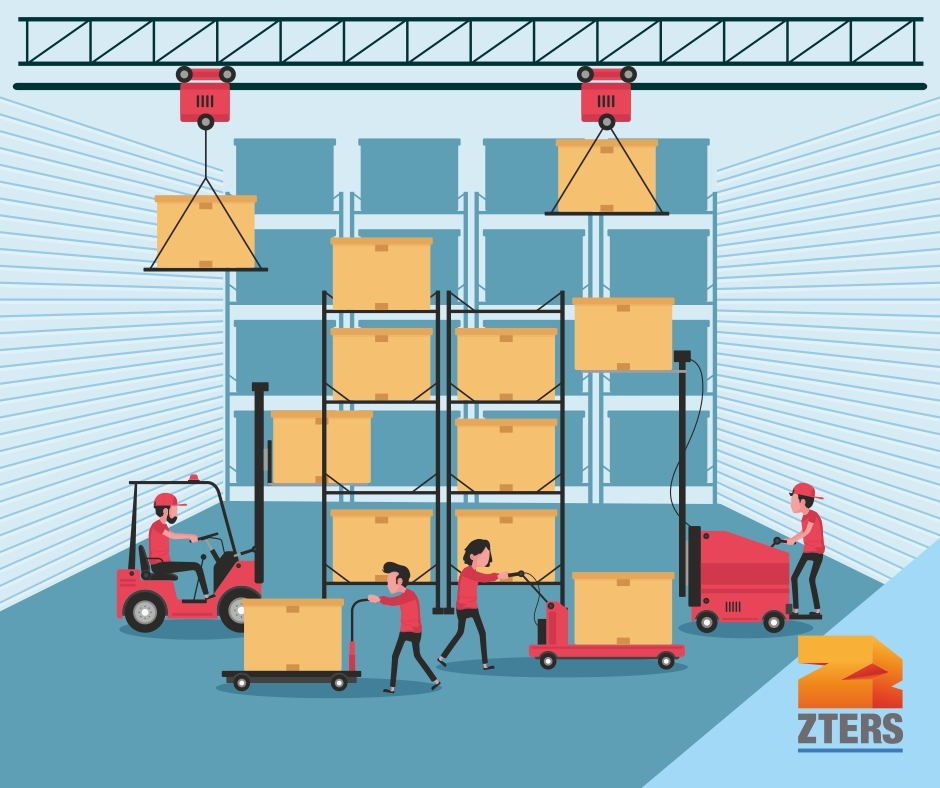Warehouse logistics is a cornerstone of supply chain management, focusing on the efficient storage, handling, and movement of goods within a warehouse or distribution center.
It encompasses processes that ensure products are stored systematically, orders are fulfilled accurately, and goods are dispatched promptly—all while minimizing costs and maximizing customer satisfaction. The first step towards sound warehouse logistics is familiarity with said logistics!
At ZTERS, we’ve worked with warehouses nationwide to provide quality waste management solutions, which is just one component of what helps warehouses run efficiently without disruptions to their operations. Here’s what you should know about warehouse logistics.
Why Is Warehouse Logistics Important?
Warehouse logistics plays a vital role in the supply chain by ensuring products are stored and shipped efficiently. Businesses that invest in effective logistics systems can reduce costs, improve order accuracy, and enhance customer satisfaction, ultimately gaining a competitive edge in the market.
Key Components of Warehouse Logistics
1. Receiving and Inspection
The logistics process kicks off with receiving deliveries. This involves verifying the accuracy of incoming shipments and inspecting goods for quality. Proper documentation and quality checks at this stage are crucial to prevent discrepancies. In other words, if mistakes are made here, it has a ripple effect further down the supply chain.
2. Storage and Inventory Management
Once received, goods are stored in designated areas. Efficient inventory management systems track stock levels, monitor product locations, and facilitate stock rotation. While this has historically been done manually, there are tons of softwares that help automate this process and can avoid human error. These systems help optimize storage space and ensure products are easily retrievable when needed.
3. Order Picking and Packing
Next comes order fulfillment, which involves picking items from their storage locations and packing them for shipment. Streamlined picking and packing processes improve efficiency, reduce errors, and support timely delivery.
4. Shipping and Distribution
The final step is dispatching packed orders to customers or retail outlets. Effective shipping and distribution require coordinated schedules and reliable transportation to meet delivery timelines and maintain customer satisfaction.
Common Challenges in Warehouse Logistics
Naturally, everything is easier said than done. While the key components of warehouse logistics sound straightforward enough, there are many areas where hiccups and blindspots can occur. Some common challenges include:
1. Inventory Management Complexity: Balancing supply and demand is essential to avoid overstocking or running out of inventory. Both scenarios can lead to increased costs and lost revenue.
2. Space Utilization: It can be challenging to maximizing the use of warehouse space without compromising accessibility and safety—especially considering the fact that you must always comply with workplace safety standards.
3. Labor Efficiency: Recruiting and retaining skilled labor, while optimizing productivity, is critical to maintaining operational efficiency.
4. Technological Integration: Implementing and maintaining advanced warehouse management systems (WMS) and automation technologies requires significant investment and expertise.
Tips for More Effective Warehouse Logistics
1. Implement Advanced WMS
As mentioned before, technology is your friend when it comes to warehouse logistics. Consider investing in warehouse management systems to improve inventory tracking, streamline order processing, and provide data analytics for decision-making.
2. Optimize Warehouse Layout
Your setup matters. Design a warehouse layout that minimizes travel time, enhances workflow, and ensures safety. Efficient layouts improve overall productivity.
3. Focus on Employee Training
Provide regular training to ensure employees are proficient with the latest technologies and operational best practices. When you invest time in training your staff upfront, it saves you time and resources in the long run because skilled staff reduce errors and enhance efficiency.
4. Leverage Automation
Incorporate automated solutions, such as conveyor systems, robotic pickers, and automated guided vehicles (AGVs), to streamline operations and reduce reliance on manual labor.
5. Adopt Continuous Improvement Strategies
Regularly assess processes using performance metrics and feedback. This helps businesses adapt to changing demands and new technologies.
Warehouse Logistics Can Transform Your Business
As you’ve read, warehouse logistics is a multifaceted discipline that requires careful planning, efficient processes, and the integration of technology. Implementing effective logistics strategies can help businesses achieve operational excellence, lower costs, and improve customer satisfaction.
If you’re looking for reliable warehouse waste management, give ZTERS a call!

